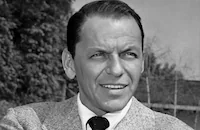The Devil at 4 O'Clock

Brief Synopsis
Cast & Crew
Mervyn Leroy
Spencer Tracy
Frank Sinatra
Kerwin Mathews
Jean-pierre Aumont
Grégoire Aslan
Film Details
Technical Specs

Synopsis
A seaplane en route to Tahiti with three convicts--Harry, a white American, Marcel, a Frenchman, and Charlie, a Negro American--makes a stopover on a tiny volcanic island in the South Pacific. The pilot deposits his fourth passenger, young Father Perreau, the replacement for aging, bad-tempered Father Matthew Doonan, whom the natives consider slightly insane because of his devotion to a mountain-top hospital he has built for children afflicted with leprosy, and who has eased his frustration with drink. The convicts are recruited to make repairs at the hospital, and Harry falls in love with a beautiful, blind nurse, Camille. One day the volcano erupts and threatens to destroy the entire island. The governor orders everyone evacuated but decides there will not be time to rescue the hospital children. By promising the three convicts paroles, Father Doonan gets them to volunteer for a rescue mission while Father Perreau nurses a broken leg. After being parachuted onto the mountain top, Father Doonan and his volunteers round up the children and personnel and begin the long, tortuous descent of the mountainside. During the trek, Harry and Camille are married by Father Doonan. As the volcano continues erupting, the journey becomes more perilous, and Marcel perishes in a quicksand mire. Later, Father Doonan and Charlie become trapped on a narrow ledge when a footbridge collapses. Harry leads the others to the safety of the beach and a waiting schooner and then races back to rescue Father Doonan and Charlie. It is too late, however, and all three men die as the island blows itself out of the sea with an ear-shattering explosion.

Director

Mervyn Leroy
Cast

Spencer Tracy

Frank Sinatra
Kerwin Mathews
Jean-pierre Aumont
Grégoire Aslan

Alexander Scourby
Barbara Luna
Cathy Lewis
Bernie Hamilton
Martin Brandt
Lou Merrill

Marcel Dalio
Tom Middleton
Ann Duggan
Louis Mercier
Michele Montau
Nanette Tanaka
Tony Maxwell
Jean Del Val
Moki Hana
Warren Hsieh
William Keaulani
Lucky Luck
Norman Josef Wright
Robin Shimatsu
Crew
John Beckman
Joseph Biroc
Larry Butler
Willis Cook
Carter Dehaven Jr.
Louis Diage
George Duning
Milton Feldman
Floyd Joyer
Fred Kohlmar
Fred Kohlmar
Ben Lane
Mervyn Leroy
Arthur Morton
Charles Nelson
Liam O'brien
Charles J. Rice
Josh Westmoreland

Videos
Movie Clip


Hosted Intro
Film Details
Technical Specs

Articles
The Devil at 4 O'Clock
It turned out to be no picnic for LeRoy. In his autobiography, Mervyn LeRoy: Take One, the director said, "what made it a problem was that the climactic scene involved a volcano, and that's the kind of thing you have to worry about and plan for with extreme care...It was done partly on a Hollywood sound stage, partly in the Hawaiian Islands. And we also used miniatures extensively. We built a mountain near La Jolla, on Gil Hodges' farm. Mostly, though, we shot in Lahaina, on the Hawaiian island of Maui. We built a lovely set there -an entire village, complete with a street, a church, and even a jail. Even though we were shooting in one of the most beautiful places on earth, it was a tough picture."
Another complication was the conflicting acting schedules of the two stars. Supporting actor Jean-Pierre Aumont, in his autobiography, Sun and Shadow, recalled that, "Spencer Tracy, a genial man who was not well at the time, couldn't work past the morning. The problem was that Sinatra would only work in the afternoon. In the morning he hired a private plane and hopped from island to island trying to convince the startled inhabitants to vote for Kennedy in the next presidential election. Around two o'clock he returned, exhausted, at the precise moment when Tracy was retiring for the day to his rooms. How, in these conditions, the scenes between Tracy and Sinatra were shot is a mystery to me."
Under these circumstances, everyone on the set expected fireworks between the two leads but they got along famously even though Tracy had some problems with Sinatra's stand-in - a broomstick. According to Richard Widmark, who heard about the filming of The Devil at Four O'Clock from Tracy, a broomstick was used in Sinatra's absence to mark his place during scenes. A script girl would read his lines and Tracy would respond in close-ups while a crew member held up a broomstick to establish the location of Sinatra's head. Despite this ploy, Sinatra actually received some good notices for his dramatic performance as a convict with a heart-of-gold. And in case you're wondering what the title means, it comes from a proverb: "It is hard for a man to be brave when he knows he is going to meet the devil at four o'clock."
Director: Mervyn LeRoy
Producer: Fred Kohlmar, Mervyn LeRoy
Screenplay: Max Catto, Liam O'Brien
Cinematography: Joseph F. Biroc
Editor: Charles Nelson
Art Direction: John Beckman
Music: George Duning
Cast: Spencer Tracy (Father Matthew Doonan), Frank Sinatra (Harry), Kerwin Mathews (Father Joseph Perreau), Jean-Pierre Aumont (Jacques), Gregoire Aslan (Marcel), Alexander Scourby (The Governor).
C-127m. Letterboxed.
by Jeff Stafford

The Devil at 4 O'Clock
Devil at 4 O'Clock -
By Richard Harland Smith
Devil at 4 O'Clock -
Quotes
Trivia
The volcano in this film was built from scratch in farmland outside Fallbrook, California. Each shot required packing with hundreds of pounds of explosives and a carefully-orchestrated "eruption" to be filmed by the cameraman seated on the front skids of a helicopter. One eruption went off a little early and nearly took out the chopper, burning off the cameraman's eyebrows and some of his hair. Because the eruptions looked so good, this ersatz volcano provided stock footage for decades of other films, commercials, etc.
Notes
Location scenes filmed on the island of Maui, Hawaii.

Miscellaneous Notes
Released in United States Fall October 1961
Released in United States Fall October 1961














